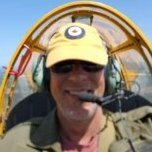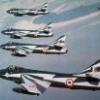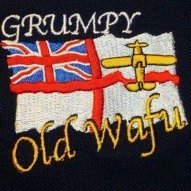

mrp
Members-
Posts
50 -
Joined
-
Last visited
Profile Information
-
Gender
Male
-
Location
Canada
Recent Profile Visitors
1,388 profile views
mrp's Achievements

New Member (2/9)
34
Reputation
-
KB700 retained dual controls throughout its service life. It was used to train new pilots on 419, after its very brief use by 405 Squadron. Looking at its service record, it did spend a fair amount of time at Maintenance Units, but did eventually do 49 missions. KB700 was the first aircraft on 419 to be equipped with H2S. I have a photo of it fitted, but annoyingly it doesn't quite show the bomb bay doors. There is a note in 419 Squadron diary about how the larger (8,000lbs) doors didn't seem to affect the H2S. It is my assumption, that it did retain the 8,000lbs doors as a grainy picture of it on 419 , prior to the H2S being fitted and the above noted comment, shows the larger doors in place. The fairing for the turret, was removed for fitting the H2S. The turret was removed shortly after it arrived in the UK in September 1943 at Avro. I would go with the 8,000lbs doors and the H2S. I haven't seen a picture that shows either the 4,00lbs or the 8,000lbs doors prior to its loss, and the ones that I have, don't really show, which is fitted. The only way to probably prove this, is a work up sheet from the maintenance unit showing the fitting of the 4,000lbs door, if it was actually done. I would assume that is buried somewhere in the National Archives, maybe someone has found this info.
- 133 replies
-

1/32 Spitfire XVI SL721 Vintage Wings of Canada
mrp replied to Bill Bunting's topic in Work in Progress - Aircraft
Here is a photo I took of SL721, just prior to it going to Belgium. All the cowlings had been removed . The photos you posted of the Merlin engine, was an earlier Mark Merlin, probably a Mark III, certainly not a Packard Merlin 266 I will look out for the other pictures, you can PM me with your email, and I can send those along. Mrp. DSC_9422 by Mark Peapell, on Flickr -
The pictures show the process of combining the Revell fuselage and the Tamiya wing and engine components. I have also attached a shot of the original Canadian built Mosquito KB336, which shows the nose contoures and bomb aimers blister, which I feel is not quite right on the HK kit. I used the Revell fuselage combined with the Tamiya wings and rudder and tailplane. All I used from the Revell kit was the fuselage.As the Mosquito fuselage is essentially a wooden tube covered with fabric and paint, the level of surface detail is negligent. Cockpit was a modified Paragon set, which took in the differences between the the fighter version and the bomber. The radio fittment was also changed to reflect the different radios that the Canadian based Mosquitos used. The build was a little tricky to get the wing set together with the fuselage, but I basically built it like the real thing, with the wing being a complete unit to fit into the fuselage from underneath.The canopy set was a Falcon set designed for the Revell kit, which elimates the use of the poor canopy mouldings. I corrected the bombaimers side windows, which on the Revell kit are too large and not the right shape and size. I bought the sprues for the Tamiya Mosquito off E-Bay, to save me from using a complete Tamiya kit. Luckily I had a complete Tamiya Mosquito in my stash, which provided the instructiona and the guide for what sprues would be needed. The Kit was built to represent a Canadian built BXX, used by 31 OTU at Debert Nova Scotia. Mark
-
The Vintage Wings P-40 has now been recently sold to Tim Savage and is now in Indiana USA. Not sure how long it will remain in Stocky's colours, but I'm sure it will retain his signature on the inside of the radio access door.
-
Just to add the this discussion, from my research and access to Canadian Lancaster production information, KB700 was the only Canadian built Lancaster to be fitted with the FN-64 turret. I have a picture of KB701, which clearly shows no underside turret fitted. There was a Canadian designed aft bomb bay fairing designed and built to fit in place, where the turret was ,with the larger 8000 lbs doors. When Victory Aircraft built the Lancaster, they would fit turrets on the production line to four aircraft , then the next four would be fitted with wooden fairings in the place of the turrets. Turrets would be fitted once the air frame had arrived in the UK at the various MU's that would bring them up to squadron operational readiness. As the turrets were built by Parnall in the UK and then subsequently shipped over via ship, the supply lines would be tight. Eventually, no turrets , except the US built Martin turret, would be fitted, starting with KB855. The MU's in the UK were spending a lot of time working on the Canadian built Lancasters and particularly disliked the wooden turret fairings, as they were attached with a multitude of small nuts and screws. So in the case of KB700, the first Lancaster off the production line, it would have had the full compliment of turrets. I am not certain, but I would suspect that the FN-64 turret probably came off the the pattern Lancaster R5727, which is pictured above with the car. The exhaust pattern showing heavy build up , would place the picture being probably taken at Gander Newfoundland, as the Lancaster was flown directly across the Atlantic to Gander, Dorval and then on to Malton, by the US aviator Clyde Pangborn. The first Canadian built Lancasters fitted with turrets at Malton were KB700, KB701,KB704 and KB705. KB706 up to KB709 would be sent out with fairings . KB710 and the next 3 would be fitted the turrets. The process would then repeat again. The Turret fairings designs were also changed over the course of their use. The fairings were built by a Toronto piano maker to a very high standard. mrp
-

Burn Down Their Hanging Trees (1/72 Airfix Lancaster B.III)
mrp replied to Procopius's topic in Work in Progress - Aircraft
The Ju-88 that defected still survives with the RAF Museum. I think it has been banished to Cosford from Hendon , with the re-organization of the RAF Museum. The RAF Museum has a good bit of information on the JU-88 here, https://www.rafmuseum.org.uk/documents/collections/78-AF-953-Junkers-Ju88-R1.pdf The book about the defection is " The Great Coup" by Robert Hall. I don't personally have a copy in my library, but it does appear that there area number of copies available on AbeBooks https://www.abebooks.com/servlet/SearchResults?sts=t&cm_sp=SearchF-_-home-_-Results&an=robert+Hill&tn=the+great+coup+&kn=&isbn= I can see a copy heading for a Chicago suburb shortly. I have recently built this kit as well. My fuselage was as equally , if not warped more than yours. Your next adventure will be fitting the wings around the spar assembly. The tolerances are very tight and requires some adjustment to get a good fit. Mark -
The dome on the CWH is not representative of the type used on the later Lancaster X (KB855 on). The prototype for the Martin turret fitting, KB783, had a a dome like the CWH one, but this was replaced with another version, on the production aircraft. This dome is similar to a B-24 top turret. The Lancaster X had more of a raised central portion. It actually looks more like a latter upper turret from a B-17. Mrp
-
It could be either 31 OTU at Debert NS, or 36 OTU at Greenwood, NS. Both were RAF run OTU's. A large number of training missions were actually anti-submarine patrols. No 31 was used to supplement Eastern Air Command operational squadrons. In fact a number of Hudsons were kept just for anti-submarine operations. I am actually involved in the restoration of a Hudson, FK466 that actually flew at Debert and participated in a number of anti-submarine patrols. A Hudson from 31 OTU actually attacked a U-Boat during one of these "training missions" on 15th May, 1943. I would note from the style and placement of the "C3", that this is more than likely 31 OTU. The Hudsons were dived into various flights, like "A", "B" and "C". This would be a "C Flight" Hudson. Mark
-
If it’s related to Martin 250CE fitted to the Lancaster, the shape of the plexiglass blown dome seems to be different than the domes fitted to B-24s and B-25s. The best examples of the Lancaster shape left are the turrets on the Ottawa Lancaster and the Calgary Lancaster. The dome on the CWH mid turret is the wrong shape. The original dome has a more pronounced drop on the front. I have a number of great shots of the turret fittment at the Victory plant, that I can send along, if you haven’t seen them. I certainly wouldn’t trust the Monogram examples, as none capture the look of the respective aircrafts upper turrets let alone the unique shape of the Lancaster Martin turret dome. MRP
-

What the heck is this thing in the Lancaster's nose?
mrp replied to Procopius's topic in Aircraft WWII
I think you may have some information in your library, given your recent Bomber Command purchases." Aircraft of 100 Group, a historical guide for the modeller" by Martin Streetly has some information on it. I think there maybe some more in "Confoundi and Destroy",, which I see you may have. There maybe also some in the Randall Wakeman book, about the science of Bomber Command, but I am not in front of my library at the moment, so I am going off memory. Certainly, I recommend the "Aircraft of the 100 Group", which is geared to modellers . Sorry to add to your wants/needs list ! mrp- 11 replies
-
- 1
-

-
- What is it
- Seriously
-
(and 1 more)
Tagged with:
-

What the heck is this thing in the Lancaster's nose?
mrp replied to Procopius's topic in Aircraft WWII
Its called Code named Z. The eyes were pair of lenses that could pick up radar signals from the rear turret of another Lancaster. This was part of the "Village Inn"defensive system, also know as the AGLT- Automatic Gun Laying Turret. A number of Lancaster rear turrets were converted to this system. A small radar transmitter was positioned below the turret and pivoted around as the turret traversed. I am not sure how many squadrons were actually equipped with these turrets, but it does appear that lots of Lancasters were fitted with the lenses, even though, they may not have actually had any AGLT's in their squadron. They were certainly retrofitted at MU's in the course of upgrades and new radios being fitted, as you can see, when you look at the centarian Lancasters. The only set, I have seen in 1/72, is with the Flightpath etch set for the Airfix Lancaster. The set provides the two circles to apply to the bomb aimer's blister. I used Future to attach. I didn't bother with the internal cups, Depending on the Lancaster, you are building, it can also have the shallower, early nose blister, with code Z attached. mrp- 11 replies
-
- 3
-

-
- What is it
- Seriously
-
(and 1 more)
Tagged with:
-

Striking Back (1/72 Trumpeter Wellington Ic)
mrp replied to Procopius's topic in Work in Progress - Aircraft
Mr P, which Freightdog Halifax correction set did you buy and where ? All I can find is the earlier sets for the Mk I/II not for the Mk III. Any help would be appreciated. mrp- 310 replies
-
- 1/72
- Wellington
-
(and 1 more)
Tagged with:
-
The deletion of all windows aft of former 6 was A.V. Roe modification number 870. Examples of other mods like the introduction of Merlin 38 engines was Mod no 845.These type of mods were introduced and approved on a regular basis.Figuring out production batches where these type of mods were introduced on the production line is the hard part. On the Canadian production line, it is also hard to determine the exact aircraft number where the change was made. The windows were very short lived though. Certainly by KB710, the eleventh aircraft off the production line, the windows were gone. In the Canadian production documentation that I have, it only lists Canadian airframe mods by serial number. Canadian airframe modifications stop at 329 , and we’re only applied to the aircraft built at Victory Aircraft. A.V. Roe mods were introduced on the line as they were approved, but aren’t listed.The mods would include the windows deletion as well as other mods like the repositioned pitot tube ,the revised nose blister shape and bulged cockpit windows. Certainly KB710 was rolled off the line at Malton during October and November 1943, to give a time line for the deletion of the windows on the Canadian production line.All this makes it problematic to make an accurate model of the later and Canadian Lancaster in 1/72 and 1/48 due to most kits having the windows for Dambuster versions of each of the respective kits ( Airfix, Revell, Hasegawa and Tamiya).
-
She is a PBY-5A Catalina . She is also the oldest surviving PBY 5-A in a museum. The crew Bob works with like to call her a Canso and no amount of stating the obvious works with them ! Canso A was designation of Canadian built ( Boeing in Vancouver and Canadian Vickers in Montreal) and were used by the RCAF. To confuse matters Vickers also built a large number of OA-10A Catalinas for the USAAF . The particular airframe that Bob is kindly working on, was built by Consolidated in San Diego > It was used by the US Navy on the East Coast of the States from 1943 until the end of war , flying out of Norfolk Virginia.After the war it served with the US Coast Guard, eventually ending up hauling freight on the East Coast of Canada with Eastern Provincial Airlines. It crashed in thew wilds of Labrador hauling diesel fuel into remote sites. It was subsequently recovered(1986) in an epic adventure, involving an CAF Chinook and Huey, along with a ferry ride and trucked to the Atlantic Canada Aviation Museum in Halifax NS. Its a Catalina plain and simple, except to the crew working on it! MRP
-
Martian, The museum is the Atlantic Canada Aviation Museum, which doesn't sell off its website. Maybe you have it confused with another museum. We have never sold off the website. Hopefully when we finish re-vamping the website, we will have the capabilities to do e-commerce. I will let Bob in the cockpit if he shows up! MRP






